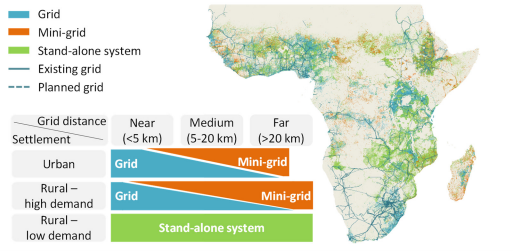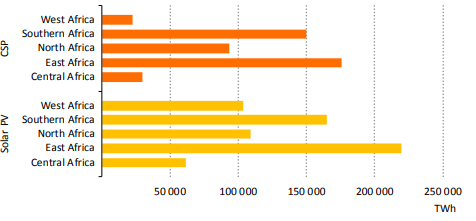
How microgrids can facilitate energy access and electrify rural Africa
Microgrids offer a promising solution for electrifying Africa's rural communities and advancing the transition to clean energy. They offer a number of advantages over traditional grid expansion, including lower costs, greater flexibility, and easier integration of renewable energy sources. However, several challenges remain, including upfront costs, energy storage, and environmental concerns.
Climate change will disproportionately impact vulnerable populations in low- and middle-income countries, who are least likely to have access to energy. Energy access is a key determinant of resilience and crucial for climate change adaptation through various channels. Some of these include improving general physical and economic wellbeing through attainment of improved health and education outcomes, building resilience through productive use activities that allow for income generation and spurring innovation and adaptation through ICTs. As of 2018, however, just over 40% of Africa’s population had access to electricity. Furthermore, per capita consumption of energy in sub-Saharan Africa (excluding South Africa) remains low at 180 kWh relative to 13 000 kWh per capita in the US and 6500 kWh in Europe.
Figure 1: Number of people without access to electricity in the world and sub-Saharan Africa, 2012 - 2022

Note: The graph plots the number of people without access to electricity as of 2022. In 2022, 80% of the people without access to electricity lived in sub-Saharan Africa. Source: IEA, 2022
The potential of microgrids as a sustainable solution to energy access
To achieve universal electricity access by 2030 as envisaged in the SDGs, 110 million connections are needed each year. Robust decentralised and off-grid solutions could play a pivotal role in bridging the electricity access gap, especially in areas of low density where grid expansion would be uneconomically expensive.
1. Microgrids are economically more feasible.
Microgrids offer several advantages over traditional main-grid technology. Traditional grid expansion with costs ranging from US$ 19,000 to US$ 22,000 per km for transmission and US$ 9000 per km for distribution, grid expansion pose significant financial costs in areas of low density. To recover these costs, utilities often need to implement cost-reflective tariffs, most of which are typically unaffordable for most rural households.
In contrast, off-grid microgrids are less capital intensive than grid expansion. They not only reduce the capital investment required but also mitigate the transmission and distribution costs associated with centralised grid systems. Furthermore, with renewables forming a larger proportion of off-grid energy sources, the cost of installation has fallen by an estimated 25 to 30% since 2014. As a result, microgrids emerge as a practical electrification solution for approximately 45% of Africa’s rural communities. In Ghana for example, decentralised minigrids have become the least cost option for extending electricity access to remote communities. Microgrids can therefore provide opportunities for growth in remote areas where traditional grid connections are uneconomical and unfeasible.
Figure 2: Projected people gaining access to electricity by technology by 2030 in Africa in the SAS

Note: The map shows the projected Sustainable Africa Scenario (SAS) in which Africa achieves all African energy‐related development goals on time and in full including universal access to modern energy services by 2030 and the full implementation of the continent’s climate pledges. Minigrids provide an important energy access especially for rural communities. Source IEA 2022.
2. By storing energy, microgrids can smoothen electricity access.
Power supply in developing countries is riddled with intermittency challenges either as a result of fuel supplies shortages, inefficient grid systems or over-demand of energy. When combined with energy storage systems, microgrids can help reduce intermittency by storing excess energy during periods of high generation and releasing it during periods of low/no generation or by acting as backup systems during periods of disruption on the main grid. This combination enhances overall reliability, ensures smoother power access and reduces intermittency challenges. This has been in observed in Tanzania for example where hybrid minigrid technologies that combine renewables and storage have been shown to improve reliability of electricity.
3. Microgrids can help expand into a more renewable energy mix.
Microgrids provide an easier way of integrating renewable and cleaner energy sources into the energy landscape. This is particularly important for developing countries that have the opportunity to leapfrog traditional fossil-based centralised grid electricity. Globally, fossil fuels still account for 80% of the energy supply. Africa possesses a lot of potential from renewable energy sources. Solar power potential for example is estimated to provide the continent with 660,000 TWh of electricity a year. Microgrids can help harness some of this potential more easily and at a faster pace.
Figure 3: Solar energy resource potential per year in Africa

Note: Africa is estimated to have a large solar potential with most of this in East and Southern Africa. CSP = concentrated solar power. Source: IEA 2019.
To achieve net-zero energy supply by 2050, renewable energy sources must constitute 60% of the power generation by 2030. Microgrids based on renewables can play a substantial role in advancing this goal. However, increasing the share of decentralised renewable energy requires deliberate policy action. In Tanzania for example, the development of licensing framework for small power producers has seen a rise in minigrid investment and activity above all other countries in Africa. Similarly, in Sierra Leone in 2016, setting an energy access goal with a focus on decentralised renewable energy coupled with awareness campaigns and using fiscal policy tools such as a quality-linked VAT/tariff exemption, saw the doubling of decentralised renewable energy market. Therefore, an enabling regulatory environment is crucial.
Challenges to development and scale-up of microgrids
A number of challenges impede the realisation of the transformative benefits of microgrids. Reliability of microgrids, especially those based on renewable energy sources require investments in energy storage systems. However, despite costs relating to storage systems having gone down over time, they still present substantial initial and maintenance costs.
In addition, microgrids face challenges in attracting finance and investment due to their relative novelty and therefore limited examples of effective business models and higher perceived risk. As such scaling of microgrids is challenging. Furthermore, since microgrids tend to be geared at remote and underserved communities, ensuring sustainability requires a balanced mix between household users and productive users as well as access to infrastructure and financing for productive users to enable their sustainability. In Indonesia, for example, successfully managing sustainability for renewable energy proved challenging as a result of low ability to pay and lack of connectivity to other infrastructure, thwarting productive energy use. This further increases the risk perception associated with microgrids.
Disposal of energy storage devices and other components raise environmental concerns. Challenges associated with recycling devices like batteries as well as the end-of-life management of such devices can have adverse impacts on the environment. For instance, solar panels waste is projected to be 78 million tonnes by 2050 and has been shown to carry the risk of leaching dangerous chemicals into the ground. Furthermore, land use for microgrid infrastructure such as wind turbines or solar panels can adversely impact local ecosystems and habitats.
Promoting sustainable microgrid development and bridging knowledge gaps
Developing and implementing microgrid projects that are responsive and environmentally friendly will require tackling these challenges. Governments need to establish an enabling environment that de-risks investments, supports innovation, and accelerates clean energy transition. Legislation that clearly spells out microgrid ownership rules can facilitate access to finance for private developers. Removing restrictions on collection of electricity tariffs and leveraging public investment to crowd in private investment can effectively reduce the initial upfront investment costs for developers. This approach not only mitigates investment risks but also paves the way for scaling up.
Environmental regulations and standards that prioritise environmental concerns are key to development of environment-friendly microgrids. These should prioritise sustainability and a circular economy to reduce e-waste related to renewable energy production. One way of incentivising safe disposal of solar panels is to place a fee on their purchase which would internalise the cost of safe removal and disposal. Channelling the disposal fee into a disposal fund managed by state or local government for recycling or removal of waste has been shown to be an economical solution in some contexts.
Addressing knowledge gaps through research can play a pivotal role in facilitating the expansion and scaling of sustainable microgrids. There are still significant research gaps in identifying efficient and effective financing mechanisms for community-based microgrids; understanding the social and economic impacts of microgrid development; and effective business models for microgrids.

